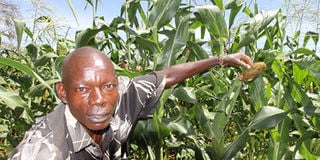Tips on growing maize during these challenging times

A maize farmer in Makueni. Maize is a nutrient intensive crop and requires adequate supplies of all minerals at all growth stages. FILE PHOTO | NMG
What you need to know:
- Maize is a nutrient intensive crop and requires adequate supplies of all minerals at all growth stages.
- Soil testing helps establish the available nutrients and the remedial steps that need to be undertaken in case of deficiencies.
- Commercially acquired certified seeds are as a standard practice dressed with a fungicide and an insecticide to prevent diseases and insects respectively.
- For better fertiliser efficiency, it is important to use the 4R principles, which are the right source of nutrient at the right rate, at the right time and in the right place.
The delayed onset of rains has caused anxiety among farmers, in particular those growing maize, as many ponder the implications of the development on their yields.
Extraneous factors such as weather patterns notwithstanding, it is important for maize farmers to pay attention to all the good standard practices needed for optimum production.
First, a farmer needs to understand their agro ecological zone, which informs the correct hybrid seed choice. One also needs to understand the soil characteristics prevalenMaize is a nutrient intensive crop and requires adequate supplies of all minerals at all growth stages. t in their field.
Maize is a nutrient intensive crop and requires adequate supplies of all minerals at all growth stages. Fertile, well-drained, well-aerated and good textured soil are able to supply needed nutrients.
However, soil pH, which is the level of acidity or alkalinity, determines the availability of nutrients on the farm. Maize crops grow best at a soil pH of between 5.5 and 7.3, with 6.0–6.5 being optimal. In this range, nitrogen, potassium, phosphorus, calcium and magnesium are readily available.
Nitrogen helps in establishment of healthy leaves, phosphorus for root formation, potassium for fruiting while secondary nutrients such as calcium and magnesium, among others, are critical for crop physiological functions.
Soil testing helps establish the available nutrients and the remedial steps that need to be undertaken in case of deficiencies.
Fertile soil should be well-prepared for sowing. The correct tillage method ensures ample availability of all plant nutrients, water retention and reduced incidences of pests and diseases.
RIGHT NUTRIENTS
It is important for the farmer to prepare for sowing by selecting the correct seed. Indeed, good seed doesn’t cost, it pays. In the case of maize, “good seed” often equates to good hybrid seed.
Commercially acquired certified seeds are as a standard practice dressed with a fungicide and an insecticide to prevent diseases and insects respectively.
A novel and growing practice is further dressing with beneficial microorganisms such as Panoramix to ensure robust growth characterised by well-established root system.
This improves nutrient and water use efficiency, resulting in a healthy resilient crop for higher yields. In addition, the correct sowing depth will ensure uniform emergence and good plant population.
During sowing, it is crucial to use the right nutrient sources, which include organic manure and fertilisers. Organic manure should be applied a few weeks before sowing.
For better fertiliser efficiency, it is important to use the 4R principles, which are the right source of nutrient at the right rate, at the right time and in the right place.
Maize also requires ‘booster nitrogen’ over the growing period. It is important to top-dress after 25-30 days of sowing and do the final top dressing after 20-25 days of first top-dressing.
It should be noted that the emergence of plants, comes with weeds that compete with maize for nutrients. It is important to remove the unwanted plants by weeding regularly.
If all these steps are followed, and the weather patterns are favourable, then the farmer is guaranteed of a bumper harvest.
The writer works at Koppert Biological Systems.




